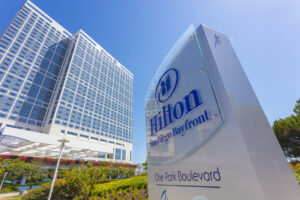High-concept comms: Crafting a Hollywood-worthy pitch
Boost your chances of securing coverage and getting your ideas approved with this principle used in the fiction and screenwriting worlds.

There’s no such thing as a “sure thing” when pitching, but as communications and PR pros know, telling an original and captivating story is key to earning media placements and approvals for even the most ambitious initiatives.
In the cinema and publishing worlds, the demand for “high concept” stories is a recurring drumbeat among literary agents and screenwriters. Well-executed, high-concept stories have major potential to capture the attention of both audiences and gatekeepers such as literary agents, publishers and studios.
Framing a story of any kind through this lens can be a great way to express why a story is powerful and drum up excitement about it.
But what does “high concept” mean, and how can we apply it to comms and PR? Let’s find out.
What are high-concept stories?
High-concept stories are based on big-picture, big-idea premises that have broad audience appeal, offer something an original twist on or mashup of familiar elements, and can be explained in as few words as possible.
These premises are often styled as “what-ifs,” “X meets X,” or “this but with that”:
- What if the genius serial killer helps the protagonist catch the antagonist? (“Silence of the Lambs”)
- It’s “The Lord of the Rings” meets the “Wars of the Roses.” (George R.R. Martin’s actual pitch for the “Song of Ice and Fire”/”Game of Thrones” series.)
- A mockumentary comedy but with vampires. (“What We Do in the Shadows”)
Sometimes, a well-executed, high-concept story can even launch a whole genre or trend by fundamentally twisting the tone and plots typical of a preexisting genre. Just look at the way “The Hunger Games” ignited an appetite for young-adult dystopian stories with female leads.
A few more examples of these ideas playing out successfully:
- Films such as “Judge Dredd” and “Blade Runner” (like Phillip K. Dick’s novels before them) helped shape the cyberpunk genre, a gritty, often-dystopian twist on preexisting science fiction. Another branch of the genre emerged when “The Matrix” mixed in superhero-like themes.
- The film “Apocalypse Now” retold Joseph Conrad’s “Heart of Darkness” set during the Vietnam War.
- “Parks and Recreation” applied the appeal and mockumentary style of “The Office” to a small-town parks department, while “Abbott Elementary” did the same in an underfunded elementary school.
How brands do high concept
How does this take shape in the comms and PR world?
Think of brands doing something so unexpected and original that they ignite a wave of copycats, related products, memes and other trends. For example:
- Volkswagen’s “Lemon” print ad, and more recently, Pepsi’s “More Than OK”. (What if a brand panned its own product?)
- Macintosh/Apple’s 1984 commercial. (Brand meets iconic dystopian story and changes the ending.)
- Nike’s Air Jordan 1 release, one of the most iconic examples of fashion and footwear brands tapping into fandom with a limited-edition (and celebrity- and star athlete-led) product drop. (Brand meets celeb +What if only the first fans scored the highly coveted product?)
- Wendy’s irreverent tone and roasts on Twitter, which led to a swath of brands developing their own irreverent social media voices. (Millennial humor but with a brand account.)
All of these examples…
- Tapped into an audience they might not otherwise be connected with.
- Reversed expectations around how a brand should behave.
- Made others want to get in on their game.
Applying the principle
Now that we have our aspirations, let’s get back down to Earth: Not every story, campaign or initiative you pitch is going to be as great an idea as the Air Jordan 1. Not every social media campaign is going to be as surprising and original as the first-ever Wendy’s roast.
And ultimately, the most powerful pitches are those in which the product, campaign or initiative itself is strong.
But you can apply the same storytelling — and storyselling — principles that make high-concept ideas attractive to any pitch, story or idea, whether you’re aiming to get a campaign covered by a news outlet or trying to pilot a new comms initiative.
Here are some ways you might strengthen your pitch (or the idea itself) by applying high-concept storyselling principles:
Make connections to similar big wins and explain what’s next.
- Is your organization simplifying its name? It might be easily explained to stakeholders by comparing it to Dunkin’ Donuts shortening its name to Dunkin’.
- If last year’s DE&I video series got the best engagement of any content your comms team ever created, explain how you plan to recreate that success by adding a new and original twist.
Draw from the headlines and research.
- The election has been dominating the news cycle, and your organization’s voter registration push aims to help people feel empowered to participate.
- Employee satisfaction is on the decline, so your comms team plans to organize a volunteer event because studies show they have a statistically high likelihood of boosting an employee’s sense of loyalty, connection and wellbeing.
Prioritize actions over individuals.
- If you’re pitching a celebrity-focused campaign, the pitch shouldn’t just be about who they are, but what they’re doing in the campaign and why they’re a good fit for the brand or product.
- If you’re writing about a new executive hire, start with what actions and accomplishments made them the right choice for the role.
- When pitching yourself for a promotion or project lead, explain what you’ve done rather than what titles you’ve held.
Use high-concept phrasing: “what if,” “X meets X,” and “this but with that.”
These can be applied to many types of pitches to explain what makes the core idea both appealing — because it’s like something that already worked — yet original. Applying these phrases to create original premises can inspire great opening lines when pitching journalists or your organization’s leadership.
- What if a celebrity marketing campaign starred an astronaut and took place in space?
- What if a CEO tangibly showed they cared about employees?
- It’s Snickers’ “you’re not you when you’re hungry” campaign meets Old Spice’s “the man your man could smell like” campaign.
- It’s an annual retreat meets a music festival.
- It’s a contender in the Chicken Sandwich Wars, but it’s vegan.
- It’s last year’s employee recognition celebration, but with a gamified UGC challenge.
Ultimately, pitching and ideating through a high concept lens can give audiences a frame of reference for understanding the potential of your story by drawing parallels to successful examples, while still emphasizing what makes it different, surprising and notable.
Jess Zafarris is the director of content for Ragan and PR Daily and an author, editor, journalist, TikTok creator and game maker.






